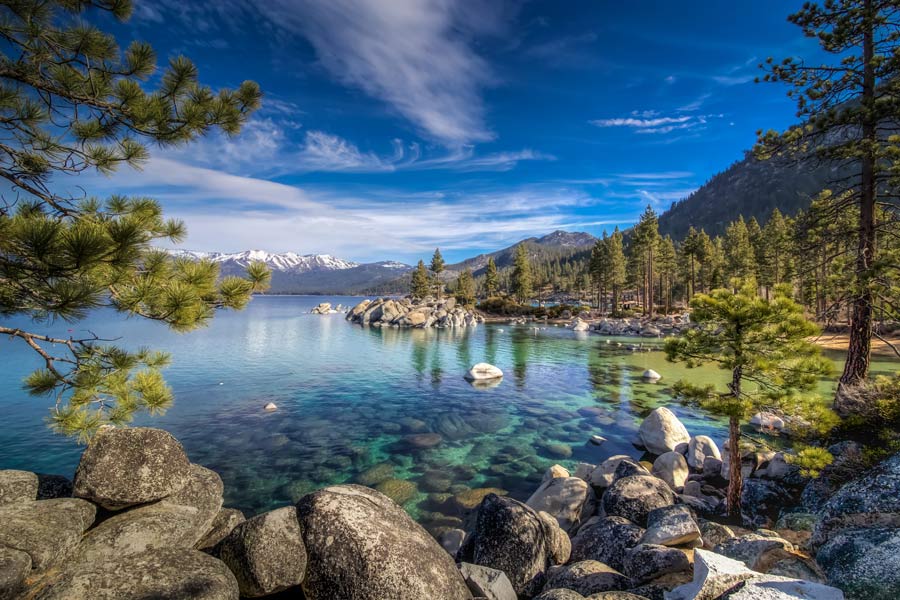California’s Black Bear Conservation and Management Plan gets an update after nearly 30 years
LAKE TAHOE, Calif./Nev. – California’s Department of Fish and Wildlife (CDFW) was operating on a black bear conservation and management plan from 1998—up until last Monday, when they released an update that will help track local populations, conserve their habitats, and consider both animal and human welfare.
The new plan aims to monitor black bear populations with more precision, then to use that data to inform decision making. It was developed with the help of two main editors, data scientists, a technical advisory group, peer reviewers, tribal input from nine Californian tribes, and public comment.
In 2022, Gov. Gavin Newsom allocated money to help update the Black Bear Conservation and Management Plan, as incidents of dangerous bear and human interactions were increasing. That same year, reports of bears breaking into homes and/or causing property damage totaled over 1,000, and the CDFW reported that one of the hotspots for this activity was the Lake Tahoe Basin—directly related to the late frost in that year and the food failures it caused for the bear population.
California has an estimated 60,000 to 80,000 black bears, placing it second only to Alaska for bear density. Lake Tahoe follows suit—with an estimated 87 bears per 100 kilometers, it has the second highest density of bears in California.
For the CDFW’s new plan, black bear populations will be monitored separately within nine bear conservation regions, which will be gathered through tooth samples and other information provided by hunters, camera traps, den checks, DNA samples from hair snare stations, and GPS collars. These will help regional decision-makers make well-informed choices on how to conserve and manage bears.
Though Lake Tahoe falls into the Northern Sierra bear conservation region, its unique bi-state position also poses a challenge for differing rules from state to state. After several groups such as the Tahoe Council for Wild Bears, Sierra Front Working Group, and Incline Bear Group fell apart, the Tahoe Interagency Bear Team was established in 2016 to connect the relevant agencies and produce standard operating procedures for areas like Taylor Creek,
“Tahoe Bears don’t really behave like wild bears,” said Sarinah Simons, California State Parks Sierra District human-bear management specialist. “This high density of bears here comes from a high number of people, especially tourists, creating attractants for bears.”
Simons emphasized the importance of “rewilding” bears—which happens both through human changes to behaviors that normalize unnatural bear behavior, and by ensuring bears don’t get accustomed to being fed by humans.
Both Nevada and California make efforts to trap and tag bears in order to gather the necessary scientific information about their lives and movements, sometimes putting GPS collars on them. Only a handful of bears have been collared between the two states, but the GPS collars aren’t put on every bear and are often deployed at different times throughout the year. Nevada has been doing this long-term research since 1997, while the California side of Lake Tahoe began their trapping, tagging, and hazing in 2022.
Hazing, while it sparks many emotions for people, is often a necessary process to prevent bears from associating humans with the reward of easy food. It’s a non-lethal solution that allows bears to remain in their home range, keeps their behavior closer to wild bears, and gives them a better chance of survival than a reliance of humans.
In Nevada, hazing typically happens after a bear is released from capture—they use Karelian bear dogs, a breed designed to hunt brown bears in Eastern Europe, to frighten the bears and create a negative association. In California, Assemblymember Heather Hadwick introduced AB 1038, which would allow trained houndsmen to use their dogs to haze bears.
The CDFW forbids people from both feeding and harassing bears, and it’s recommended to discourage human-bear interaction. Food is the number one attractant for bears and is most often found in garbage, empty homes, or camps—using bear-resistant containers when possible and properly securing them is one of the most important ways to deter bears from getting too friendly.
Lastly, California and Nevada both emphasize BearWise principles for residents and tourists alike to stay safe when interacting with bears:
- Never feed or approach bears
- Secure food, garbage, and recycling,
- Remove bird feeders when bears are active
- Never leave pet food outdoors
- Clean and store grills and smokers
- Alert neighbors to bear activity
Eli Ramos is a reporter for Tahoe Daily Tribune. They are part of the 2024–26 cohort of California Local News Fellows through UC Berkeley.

Support Local Journalism

Support Local Journalism
Readers around the Lake Tahoe Basin and beyond make the Tahoe Tribune's work possible. Your financial contribution supports our efforts to deliver quality, locally relevant journalism.
Now more than ever, your support is critical to help us keep our community informed about the evolving coronavirus pandemic and the impact it is having locally. Every contribution, however large or small, will make a difference.
Your donation will help us continue to cover COVID-19 and our other vital local news.











